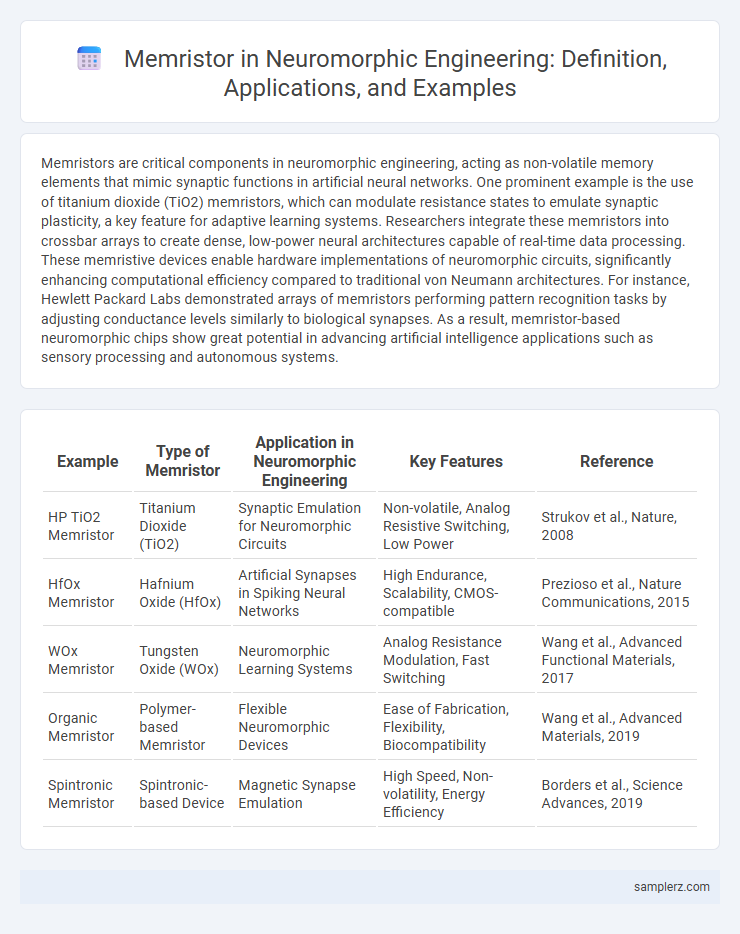Memristors are critical components in neuromorphic engineering, acting as non-volatile memory elements that mimic synaptic functions in artificial neural networks. One prominent example is the use of titanium dioxide (TiO2) memristors, which can modulate resistance states to emulate synaptic plasticity, a key feature for adaptive learning systems. Researchers integrate these memristors into crossbar arrays to create dense, low-power neural architectures capable of real-time data processing. These memristive devices enable hardware implementations of neuromorphic circuits, significantly enhancing computational efficiency compared to traditional von Neumann architectures. For instance, Hewlett Packard Labs demonstrated arrays of memristors performing pattern recognition tasks by adjusting conductance levels similarly to biological synapses. As a result, memristor-based neuromorphic chips show great potential in advancing artificial intelligence applications such as sensory processing and autonomous systems.
Table of Comparison
| Memristor Type | Material Composition | Neuromorphic Application | Key Feature | Reference Example |
|---|---|---|---|---|
| TiO2-based Memristor | Titanium Dioxide (TiO2) | Synaptic Weight Storage | Analog Resistance Switching | HP Labs Memristor Model |
| WOx Memristor | Tungsten Oxide (WOx) | Spike-Timing Dependent Plasticity (STDP) | Low Power Operation | Stanford Neuromorphic Chip |
| HfOx Memristor | Hafnium Oxide (HfOx) | Artificial Synapse Implementation | High Endurance and Scalability | IBM Research Prototype |
| Organic Memristor | Polymer-based Materials | Flexible Neuromorphic Circuits | Biocompatibility and Flexibility | University of Michigan Research |
| InGaZnO Memristor | Indium Gallium Zinc Oxide | Neuromorphic Visual Processing | High Switching Speed | KAIST Neuromorphic Studies |
Introduction to Memristors in Neuromorphic Engineering
Memristors play a critical role in neuromorphic engineering by mimicking synaptic functions in artificial neural networks, enabling efficient data storage and processing. Their non-volatile resistance states allow for energy-efficient learning algorithms and real-time signal processing in neuromorphic systems. Key examples include memristor-based crossbar arrays used to implement synaptic weights, significantly advancing hardware for brain-inspired computing architectures.
Role of Memristors as Artificial Synapses
Memristors function as artificial synapses in neuromorphic engineering by emulating the adaptive weighting behavior of biological synapses, enabling efficient hardware-based learning and memory retention. Their inherent ability to modulate resistance in response to electrical stimuli allows for real-time synaptic plasticity, which is crucial for developing brain-inspired computing architectures. This synaptic mimicry facilitates low-power, high-density neural networks that advance machine learning and cognitive computing applications.
Memristor-Based Neural Networks: Case Studies
Memristor-based neural networks demonstrate significant advancements in neuromorphic engineering by enabling low-power, high-density memory storage and adaptive learning capabilities. Case studies reveal that memristors facilitate synaptic plasticity, closely mimicking biological neural functions and improving the efficiency of pattern recognition tasks. These networks enhance hardware scalability and speed, crucial for applications in real-time sensory processing and artificial intelligence systems.
Experimental Demonstrations of Memristor Synapses
Experimental demonstrations of memristor synapses have highlighted their potential to emulate biological neural networks by enabling efficient spike-timing-dependent plasticity (STDP) learning rules. Recent studies utilize hafnium oxide-based memristors to achieve low-power, high-density synaptic arrays capable of real-time learning and adaptation. These memristive devices exhibit analog resistance modulation, closely mimicking synaptic weight updates critical for neuromorphic computing architectures.
Analog Memory Storage using Memristors
Memristors play a critical role in neuromorphic engineering by enabling analog memory storage that mimics synaptic behavior in biological neural networks. Their ability to retain resistance states without power allows for energy-efficient, non-volatile data retention and adaptive learning processes. This analog storage capability enhances the development of brain-inspired computing systems with high-density memory and real-time processing.
Memristive Crossbar Arrays for Deep Learning
Memristive crossbar arrays serve as a fundamental hardware platform for deep learning by enabling high-density, low-power synaptic weight storage and computation in neuromorphic engineering. These arrays leverage memristors' ability to perform analog matrix-vector multiplication directly within memory, dramatically enhancing processing speed and energy efficiency. Their integration into neuromorphic chips facilitates scalable, real-time learning and inference, advancing deep neural network architectures beyond traditional von Neumann limitations.
Energy-Efficient Neuromorphic Hardware with Memristors
Memristors enable energy-efficient neuromorphic hardware by mimicking synaptic functions with ultra-low power consumption and high scalability. Their ability to store analog states allows for dense memory arrays that reduce energy demands in artificial neural networks. Advanced memristor-based crossbar architectures significantly enhance computational speed while minimizing energy use in neuromorphic systems.
Spiking Neural Networks Implemented with Memristors
Spiking Neural Networks (SNNs) implemented with memristors demonstrate significant advancements in neuromorphic engineering by mimicking synaptic plasticity through variable resistance states. Memristor-based SNNs enable energy-efficient and high-density integration, allowing for real-time processing of spatiotemporal data in brain-inspired computing systems. These networks leverage memristors to achieve adaptive learning and memory retention, crucial for scalable and robust artificial intelligence applications.
Memristor Emulation of Synaptic Plasticity
Memristors emulate synaptic plasticity by mimicking the dynamic weight adjustment observed in biological synapses, crucial for neuromorphic engineering applications. These devices enable the modulation of conductance levels in response to electrical stimuli, effectively replicating long-term potentiation and depression. Memristor-based synapses facilitate energy-efficient, scalable neural networks that improve pattern recognition and learning capabilities in artificial intelligence systems.
Future Prospects of Memristors in Brain-Inspired Computing
Memristors are poised to revolutionize neuromorphic engineering by enabling highly efficient, brain-inspired computing systems that mimic synaptic behavior with low power consumption and high density. Future advancements in memristor materials and device architectures will enhance scalability and learning capabilities, driving the development of advanced artificial intelligence applications and real-time data processing. Integration of memristors with CMOS technology promises hybrid systems that combine the best of traditional and neuromorphic computing paradigms for next-generation cognitive computing.

example of memristor in neuromorphic engineering Infographic
 samplerz.com
samplerz.com